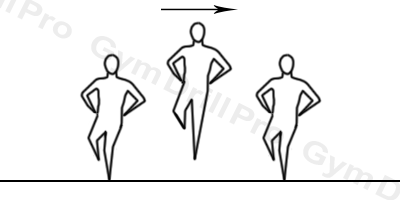


There are several modifications of the Scale. The two primary ones are lateral or frontal scales. Both can be performed with the raising leg being held above horizontal or up to vertical, and with the raising leg being held or not. The most common scale is the frontal scale. It starts in a standing position with the arms up. The gymnast then makes a step and lunges on the standing leg. The arms should lower to the lateral horizontal position. Then the back leg raises above the horizontal position. It’s very important to first raise the leg, then lower the body afterward. The skill finishes when the upper body lowers to horizontal and the raised leg is above horizontal. The arms should stay sideways at shoulder height.

A split is a demonstration of exceptional hamstring and anterior hip flexibility. The goal of a split is to lower the body so that the legs are at an 180-degree angle, parallel to the floor. Splits can be used as a stretching exercise or warm-up for the leg muscles. This body position is very important for a number of skills in gymnastics, and can make progressions much easier (flairs, endos, jumps, etc.). It also helps to prevent injury by improving the range of motion for certain muscle groups. Splits should be practiced frequently, ideally every day for 5-10 minutes. There are several variations of a split: right leg, left leg, and middle. It’s necessary to practice each of these positions until the gymnast can reach the floor. Once this goal has been achieved, the gymnast can gradually begin to practice an oversplit by placing their legs on an elevated surface like a panel mat or 8 incher.

The gymnast should stand on one leg, with their hands on their hips (this prevents them from swinging their arms and using them for momentum and balance). The gymnast should keep their back completely straight with their head neutral. They should then hop forward, remaining on one leg. The other leg should be straight and raised in front, sideways, or back, up to horizontal, and should hold it during the execution of the drill. They should repeat this motion several times, completing 5-10 hops forward. They should repeat this drill using the other leg, with the same technique.

Stand on one leg for a period of time (10+ seconds). Arms should remain by the gymnast’s sides, or on their hips. This prevents them from being used for balance. The balance should come entirely from the standing leg and ankle. The other leg should be straight and raised in front, sideways, or back, up to horizontal, and should hold it during the execution of the drill.Then repeat with the other leg. Do not move during the holds.
Integral part of gymnastics coaching process are skill drills. They help gymnasts to learn easier and technically correct. With GYM DRILL PRO you will find variety of ideas for the most the basic gymnastics skills. There are plenty of images with skill drill progressions. It is intended to support explicitly the qualified coaches in their daily coaching business. DO NOT practice without the guidance of proper professionals.